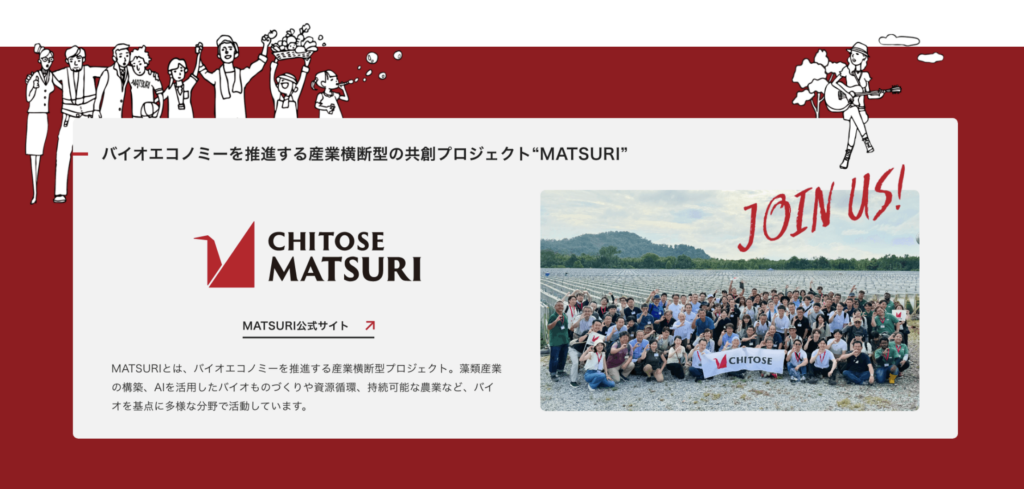
What comes to mind when you hear “algae”? A green layer in a pond, or seaweeds like kelp and wakame?
Now, algae are drawing attention as materials that could support future lifestyles. At Expo 2025 Osaka, Kansai, the Japan Pavilion features algae as one of its key themes. CHITOSE’s cross-industry initiative, MATSURI, is showcasing “ALGAL by MATSURI” — a window into the future, filled with fashion, cosmetics, food, and paints made from algae.
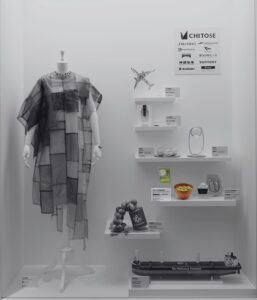
The freeze-dried miso soup made with microalgae spirulina was developed by Maruha Nichiro, a leading company in the seafood industry. This innovation takes a stage at the Japan Pavilion of the Expo 2025 Osaka, Kansai. Under the pavilion’s concept, “Between Lives,” various installations prompt visitors to reflect on the theme of “circulation.” The algae miso soup is one such thought-provoking piece. By enjoying the miso soup at the Japan Pavillion, visitors themselves become part of the cycle.
Spirulina is a nutrient-rich “super-food” containing abundant protein, vitamins, and minerals. The World Health Organization (WHO) has even called it “one of the best protein sources for humanity in the 21st century.” It is no coincidence that this food of the future caught the interest of Maruha Nichiro — a company of “seafood experts,” who have supported Japan’s seafood industry through the development of refrigeration and freezing technologies, with a history dating back to the late 19th century.
However, incorporating microalgae into something as everyday as a bowl of soup came with its own set of challenges. Why did Maruha Nichiro venture into the microalgae industry, and why present it in the form of miso soup? What kind of future are they envisioning beyond this showcase? CHITOSE sat down with three Maruha Nichiro team members, who led this project, to find out.
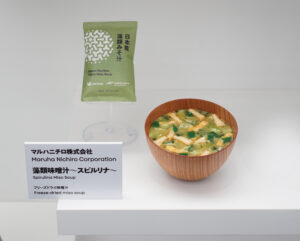
Featured in This Interview
Naoya Imamura
Product Development & Manufacturing / Freeze-Dried Foods Section, Seasonings & Extracts / Freeze-Dried Foods Department, Maruha Nichiro
— Favorite food? “Ramen!”
Shisei Kuninaga
Quality Assurance / Quality Management Section, Quality Assurance Department, Maruha Nichiro
— Favorite food? “Sushi—lately I’m into comparing different kinds of yellowtail like buri and hamachi.”
Mitsunobu Makino
Food Products / Business Section 1, Institutional Foods Distribution Business Department, Maruha Nichiro
— Favorite food? “Wait, alcohol doesn’t count…? Then I’ll say squid and fish cakes (laughs).”
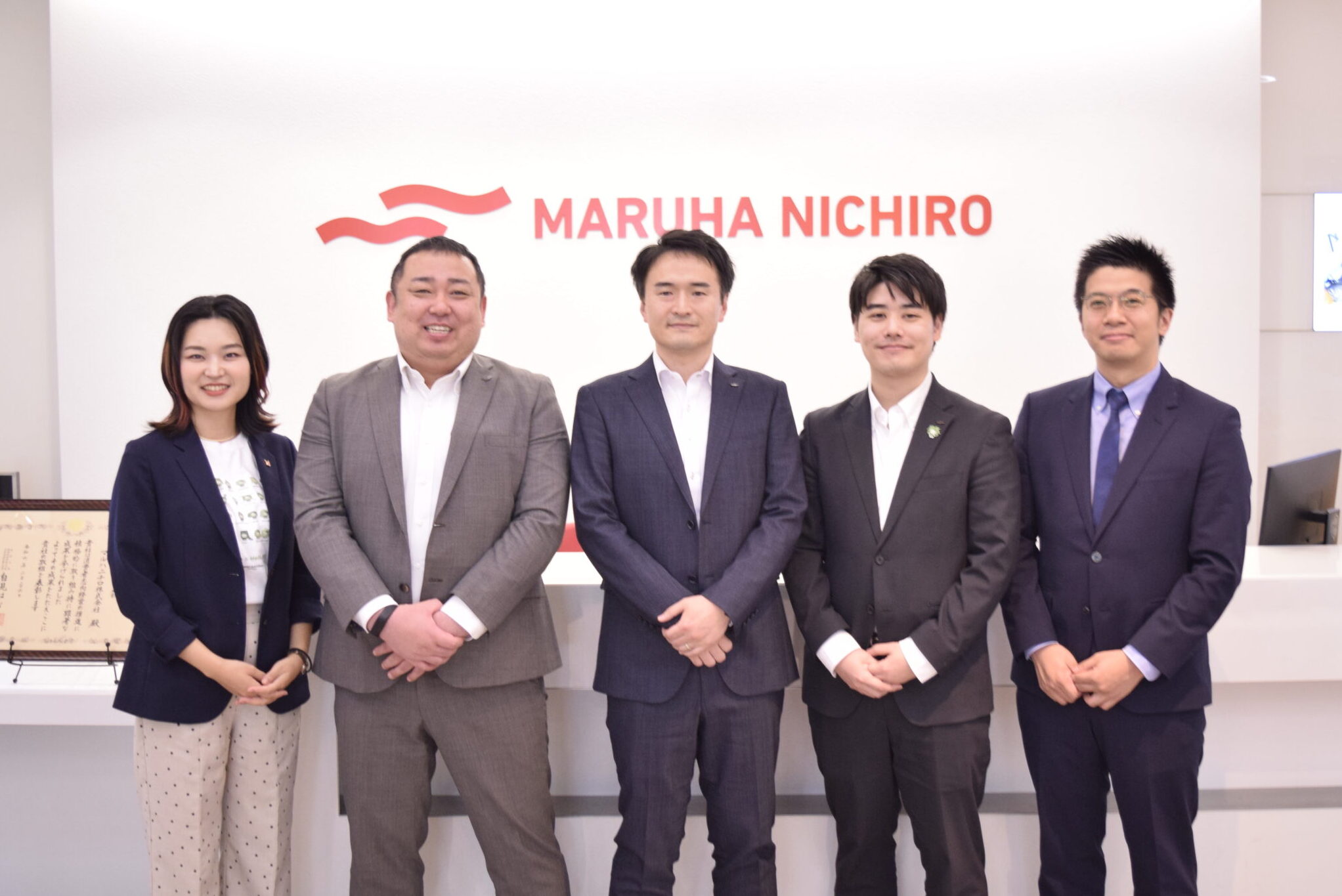
Why Did Seafood Experts Put Algae in Miso Soup?
— To start, how did a seafood company like yours end up working with microalgae?
Mr. Makino – Food Products, Maruha Nichiro:
The starting point was an internal project launched to explore next-generation protein, with a view toward 2040 and 2050. As the global population grows and people’s diets change rapidly, we recognize the need for new protein sources to support the future of food. That’s when we saw potential in microalgae.
Mr. Kuninaga – Quality Assurance, Maruha Nichiro:
There’s a term known as the “protein crisis*.” Up until now, Maruha Nichiro has primarily provided high-quality protein through fish. But we may eventually reach a point where that alone can’t meet the ever-growing demand. That’s why, through this project, we’re testing whether it’s possible to create something truly delicious using ingredients we’ve never worked with before, and whether it can be sustained as a business.
Another key reason we see potential in microalgae is its role in ensuring a stable food supply. Wild-caught fish, by nature, come with a high degree of volatility. For instance, in recent years, it’s become harder to catch fatty mackerel in Japanese waters. Fish are highly sensitive to changes in the global environment. And when you factor in overfishing, geopolitical risks, and currency fluctuations, securing a stable supply becomes extremely difficult.
That’s why we believe the role of protein sources that are less vulnerable to environmental and geopolitical instability will become increasingly important in the future.
* The “protein crisis” refers to a situation in which the demand for protein outpaces supply due to population growth and changing dietary habits. It’s predicted this could happen as early as 2030.
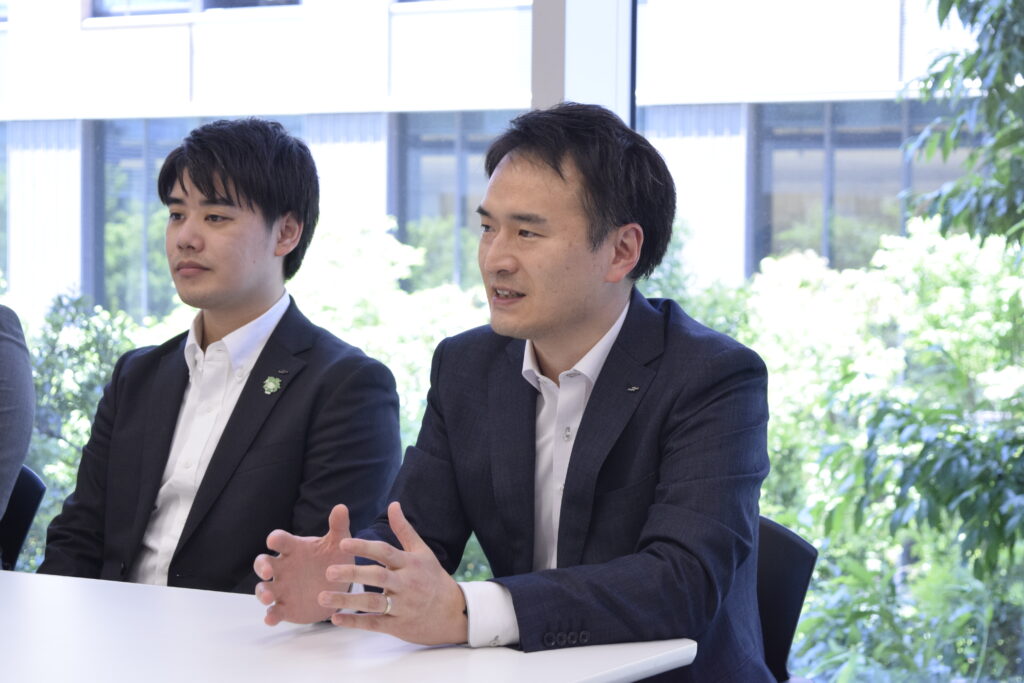
— Why did you decide to present spirulina in the form of miso soup?
Mr. Makino – Food Products, Maruha Nichiro:
Actually, there were several requirements we had to meet in order to distribute the product at the Japan Pavilion. It needed to be shelf-stable at room temperature, produced at a scale of hundreds of thousands of servings, and packaged in a way that didn’t require immediate consumption, so as to minimize waste at the venue.
With these requirements in mind, we wanted to offer a familiar staple of Japanese cuisine, something we could deliver with great confidence. That’s how we arrived at freeze-dried miso soup.
— Were there any challenges you faced along the way?
Mr. Makino – Food Products, Maruha Nichiro:
Sometimes, even inside the company, we’d hear things like, “What are you guys doing?” or “Don’t you have anything better to do?” But we just said, “Just wait and see!” and pushed through (laughs). Of course, we knew it wouldn’t be an easy path. But since it was a matter of succeeding or failing, we were strongly determined.

Before Spirulina Miso Soup was Made
— How do you make freeze-dried algae miso soup?
Mr. Imamura – Product Development & Manufacturing, Maruha Nichiro:
It’s hard to imagine, isn’t it? But up to a certain point, it’s the same process as for regular miso soup.
We prepare miso soup in large pots, similar to those used in school lunch kitchens, and then add spirulina. However, at this stage, we adjust the amount of water to be on the lower side. If the soup is too watery, the ingredients will sink and become uneven when portioned out. Since we also remove moisture later in the process, we start with less water from the beginning.

Once the green-colored miso soup is ready, it’s poured into trays with square molds. These molds are for the freeze-drying process.
After pouring, the soup is frozen overnight. At this stage, some water content is already removed. Next, the trays go into a large machine called a “vacuum freeze-dryer,” which looks like a submarine.
Inside this machine, a vacuum is created, allowing a process called “sublimation” to occur—where ice changes directly into steam without passing “water” status. In other words, the water is removed as vapor while the soup remains frozen, resulting in freeze-dried miso soup.
Finally, the product is packaged after undergoing strict quality inspection.
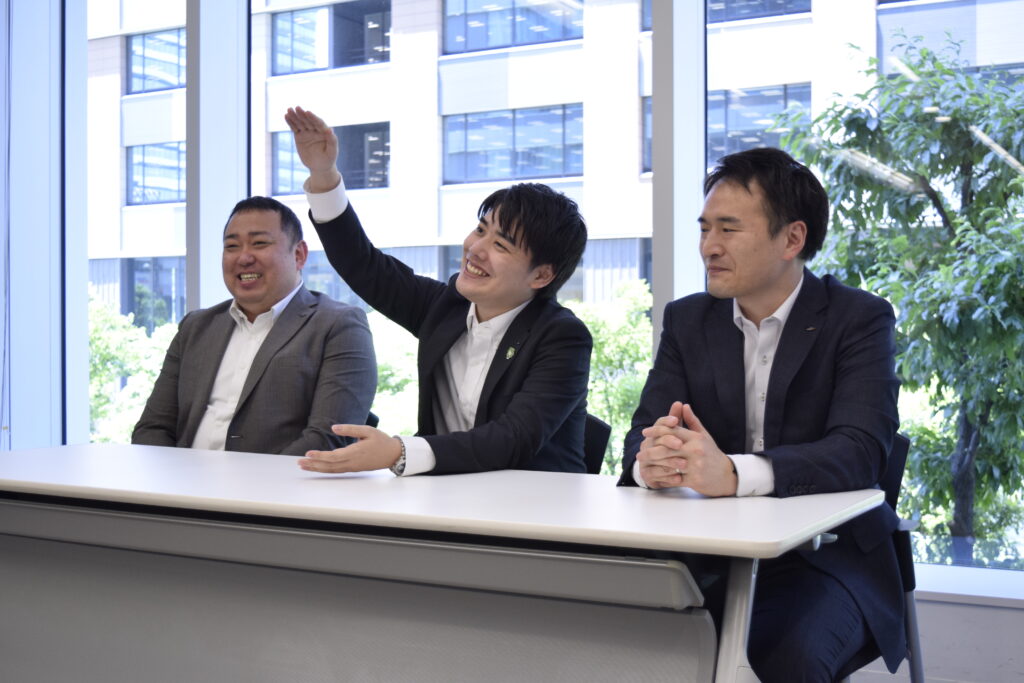
— What are the key features of the Spirulina Miso Soup?
Mr. Imamura – Product Development & Manufacturing, Maruha Nichiro:
The standout feature, of course, is that it contains spirulina. And this time, we wanted to make the presence of spirulina really noticeable, in line with the Expo’s concept of being a “”
Spirulina is heat-sensitive, it turns brown once overheated, so we carefully adjusted the production process to preserve its vibrant green color to visualize its uniqueness.
As for the ingredients, we included light green cabbage and dark green spinach. These greens overlap with the spirulina’s green, and we hope people will enjoy the contrasting textures and flavors that bring into the miso soup.
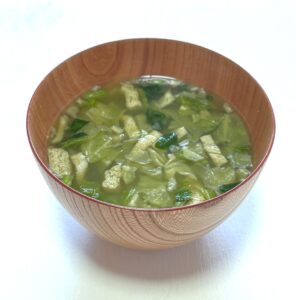
The Normal of Tomorrow, Created Today
Up to this point, we’ve explored the story behind the creation of Spriulina Miso Soup. But the question now is: how do we connect this to the future? The discussion moves into its next phase.
— In order to make microalgae a mainstream ingredient in the future, how much production volume do you think will be needed, and what steps will it take to get there?
Mr. Kuninaga – Quality Assurance, Maruha Nichiro:
If we’re going to seriously address the “protein crisis,” then we’ll eventually need microalgae to play a major role in solving it, with enough supply to account for a significant portion of our food supply. But this isn’t something that’s going to happen overnight.
It’s more like the adoption of hybrid cars. Just as not all vehicles suddenly became electric, the same gradual transition applies to food. I believe the food world will evolve by finding the right balance with existing ingredients.
After all, we know how delicious tuna and beef steak are, so eliminating them entirely just isn’t realistic. What we’re aiming for is to find what role algae can play in the future and introduce it to society as a new option.
Mr. Makino – Food Products, Maruha Nichiro:
As a food company, we believe the first step is getting people to think, “This tastes good! Maybe I’ll eat it more often.” Spirulina is incredibly nutritious, but if it doesn’t taste good, it won’t be widely accepted. Ideally, we want people to notice later on, “I’ve been feeling better lately,” and realize that microalgae had something to do with it.
Ultimately, we’d love for microalgae to become part of everyday meals, just like miso soup, something that naturally finds its place on the table. I see real potential in products like hamburger patties or fish sausages where microalgae makes up most of the ingredients.
And in the sweets category, green is already an appetizing color thanks to matcha, so I think accepting microalgae as an ingredient would be easier than expected.
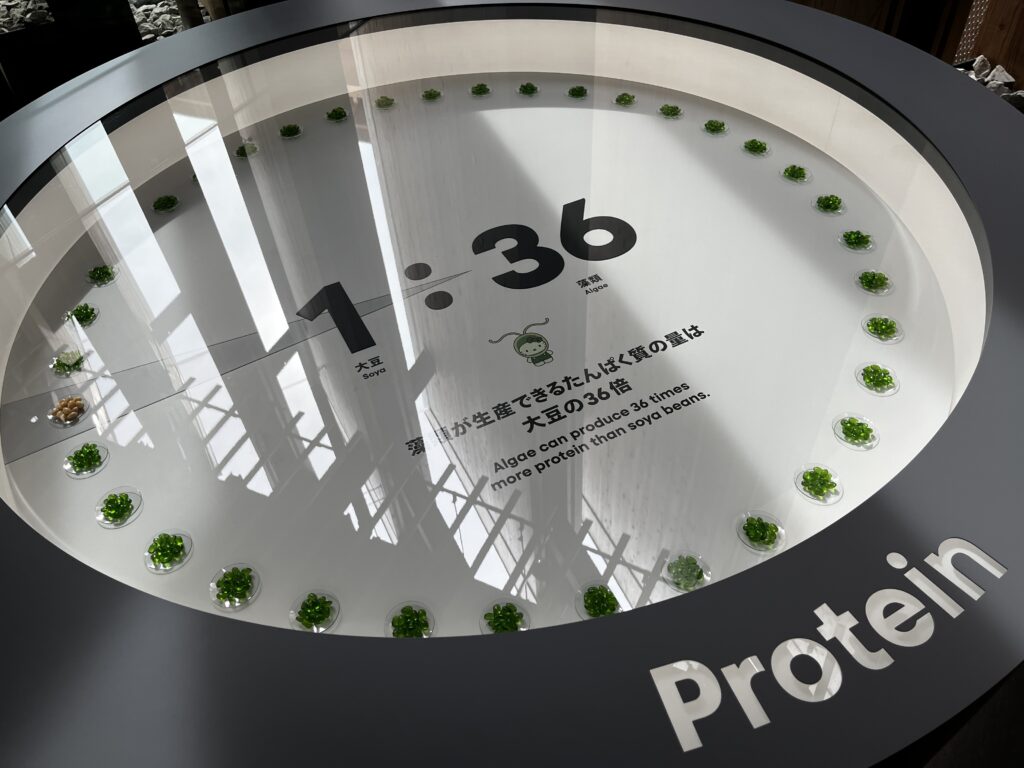
— Lastly, what message would you like to share with visitors and future generations through the Expo?
Mr. Kuninaga – Quality Assurance, Maruha Nichiro:
The theme of the Osaka–Kansai Expo is “Designing Future Society for Our Lives.” I find it symbolic that such a dazzling global event focuses on something as fundamental as “life.”
As people working in the food industry, which is connected to “life”, it’s a real honor to be a part of this initiative. I hope that with microalgae as a starting point, we can inspire many people to think more deeply about the future of food.
Mr. Makino – Food Products, Maruha Nichiro:
Actually, I was also involved in the Expo 2005, Aichi, Japan, and looking back, many technologies that were considered difficult back then have become completely normal by 2025.
Everything that’s “normal” today must have gone through a tough beginning. But once something starts to catch on, it can spread quickly. Right now, there are still many challenges to overcome, but when I think back to the 2005 Expo—and imagine what things might look like 20 years from now—I can’t help but grin.
Wouldn’t it be fun if, in a future where microalgae has become a mainstream food, someone remembered: “Oh yeah, weren’t they handing out algae miso soup at the Expo!”?
Written by Natsuho Konno / Translated by Tanya Topolian


